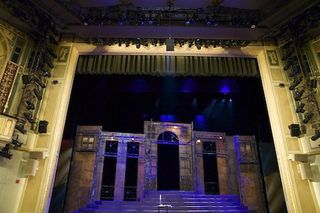
- Meyer Sound is focusing on continually improving on the point source platform in products like the JM-1P arrayable loudspeaker. One Way Media Solutions of Benicia, California designed and installed a JM-1P system for the Theatre DeVille (pictured) in Vacaville, California. The “wow” factor in loudspeaker technology over the last decade-plus has resided firmly in the line array column. Consequently, installers and manufacturers have placed a great amount of emphasis on line arrays in recent years. So where does this leave the venerable point source loudspeaker?
With a multitude of factors playing into making the appropriate loudspeaker configuration choice for installations, from the type of source to an overall package to price points, both line array and point source loudspeakers are alive and well.
Today, manufacturers are spending resources perfecting their product lines and stressing the appropriate applications of both point source and line array loudspeaker configurations.
QSC is one of many companies pursuing new technologies that aim to enhance existing, tried-and-true components.
“There is a slow trend moving toward considering the power response of a loudspeaker—not just a frequency response, but the holistic performance off axis,” said Travis Nie, product manager, installed loudspeakers, at QSC. “Traditionally, installers and integrators looked at the pattern control of a loudspeaker in determining which one to select, such as 60x40 waveguides. But when you do that, you only have frequency control at certain points of the waveguide.”
Technology such as directivity-matched transition allows the company to achieve a uniform performance and improved off-axis performance, according to Nie.
“We take the performance of the woofer as it starts to go up in frequency,” he said. “and we match that performance at the crossover point to a high-frequency waveguide, so a 10-inch speaker is a 90-degree conical pattern. That achieves a much more uniform performance and much better off-axis performance as a result.”
Steve Bush said Meyer Sound is also focusing on continually improving on the point source platform in products like the JM-1P arrayable loudspeaker.
“Horn advances result in more consistent on- and off-axis frequency response, and this certainly provides a performance advantage to customers using point source systems,” said Steve Bush, senior technical support specialist and seminar instructor at Meyer Sound.
“The precision of the horn on the JM-1P gives customers an extremely accurate 60- by 20-degree coverage pattern, making tightly packed arrays possible and eliminating the need for angle setting.”
But what may appear to be a renaissance in point source system design is more realistically a leveling of the marketplace in favor of using appropriate technologies. Joe Rimstidt, systems design engineer at Yamaha Commercial Audio Systems, said that line arrays remain a logical choice in certain spaces due to fundamental differences between point sources and line arrays.
“Few point source systems array really well, because there's a lot of interaction between the components,” said Rimstidt. “If you're going to put multiple loudspeaker cabinets in a cluster, line arrays are easier to tune properly than point source arrays.
“The steered column array is one technology that is gaining traction because it’s easier to provide one more tool where it's important to remain in a vertical column against a wall. Otherwise the market is seeing continual improvements in existing designs, tweaking drivers and horn designs to make them better.”
Packaged systems are also growing in popularity as manufacturers develop products that support their flagship lines. The idea is that by providing a turnkey system that includes many of the necessary components, those systems will provide an easier path to quality sound on installations.
Benefits of packaged systems can range from point-source loudspeakers that have built-in processing to power amps that can set up arrayed systems through native processing.
“Definitely there are some advantages to using one manufacturer,” said Nie, who markets intrinsic correction voicing, a loudspeaker tuning technology available in QSC’sprocessing and power amplifiers to enhance the company’s product packages.
“There is a paradigm shift—we’re getting away from selling boxes,” said Nie. “We’ve never been or aspire to be the cheapest game in town. We lean toward providing a package. We know that QSC speakers played through QSC amps sound intrinsically better. By being a one-source provider, not only do you maximize the technology within the product, but you also have just one manufacturer to go back to. I think that brings a lot of value.”
Installers and consumers benefit, Nie said, from having the research and development done by a single group of engineers that are working together to make loudspeakers, power amplifiers and processors that complement each other.

Joe Rimstidt, systems design engineer at Yamaha Commercial Audio Systems, said that line arrays remain a logical choice in certain spaces due to fundamental differences between point sources and line arrays. Pictured here is NEXO’s GEO M620 line array system installed in the Hanna Theatre in Cleveland, Ohio. “The added value of having a complete system provider is that a lot of R&D took place to get the most performance out of a system, which means less time in the field for integrators. We’ve designed them to be a complete package. Our entire engineering team works in the same building, so our amplifier engineer works alongside the loudspeaker engineer, and we can make sure that we can drive those products as hard as we can without causing failure.”
Now that systems integrators have a variety of mature technologies at their disposal, the need for deploying them in the correct manner is as important as ever. Software such as EASE Focus, as well as the processing technologies included in some loudspeakers and power amps, helps designers apply these systems appropriately.
“It is true that more and more audio practitioners are now defining a system design based on the requirements in an application, instead of putting line arrays everywhere,” Meyer’s Bush said. “A contributing factor is the increasing amount of educational resources that are available for learning the scientific principles that are so important in designing the right system for the job.
“All great audio installations are a result of picking the right loudspeakers, putting them in the right place, and aiming them in the right direction. It sounds simple, but those who have done this successfully know that all of this goes back to understanding the basic audio principles.”
Now that manufacturers have mastered the state of the art in line arrays, Rimstadt said it’s unlikely that integrators would choose a point-source system where a line array would work best.
“Over the last decade or so, there have been a lot more line array installations because there are a lot more line array products and everyone has developed good products,” Rimstadt said. “It took everybody a while to find the best components, and now people have discovered the benefits of a line array in the right room.
“Hopefully the system designer will look at the overall situation and make the best decision. I haven't seen a huge amount of inappropriate applications. Line arrays are great tools in a lot of applications, but it has to fit the budget and the requirements of the solution.”
As many integrators can attest, there are also the issues of price and meeting customer expectations on strained budgets. Working to achieve optimal “bang for the buck” isn’t limited to professional AV—it’s a universal concern.
“Price is always going to be part of the decision,” said Rimstadt. “For any purchaser, the decision always boils down to an overall value.”
Instilling realistic expectations that fit the customer’s budget can make the process easier, Rimstadt added. In real-world situations, there are often compromises made among price, source and packages.
“I encourage customers to figure out their budgets. When they come in and say they want to have the best system for their venue, I need to know where they stand. What is appropriate and what do you have to spend?”
“Any group purchasing has to be realistic. They should do their homework and get the best value without selling themselves short. Someone can always come up with something that costs less, but it won't be the same.”
Jim Beaugez, APR, is a freelance writer and accredited communications professional with a decade of experience in the MI and pro audio industries. You can reach him at jimbeaugez@gmail.com and on Twitter @JimBeaugez.










